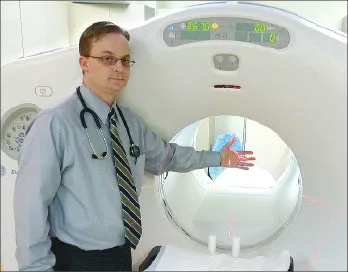Cancer Care Northwest buys new imaging device
$2 million GE scanner at Deaconess combines CT, PET technologies

Spokane-based Cancer Care Northwest has purchased and installed a new $2 million imaging machine that it says will help physicians here detect, pinpoint the location of, and assess the stage of various types of cancer.
The machine is located in Cancer Care Northwest's offices at Deaconess Medical Center. It combines the technology of computerized tomography (CT), which takes clear pictures that show the precise location of suspicious activity in a person's anatomy, and positron emission tomography (PET), which provides metabolic information that tells physicians about the nature of the tumor, the cancer center says.
Previously, doctors had to put patients through separate CT and PET exams to get that amount of information, says Christopher Lee, a radiation oncologist at the cancer center. Also, because the images were captured at different times with different scanners, fusing them together and comparing them was difficult, Lee says.
The new imaging machine—made by General Electric Corp. and called the Discovery STE PET/CT scanner—allows doctors to gather both anatomical and metabolic information in one session, Lee says. A single exam helps physicians answer critical questions, such as the size of a tumor, whether it's spreading, and if it's malignant. It also helps them determine the best treatment, and whether any current treatment is working, he says.
The Discovery STE is helpful to radiologists, nuclear medicine professionals, radiation oncologists such as Lee, surgical oncologists, and referring physicians, the cancer center says. It accurately locates lesions and differentiates malignant lesions, benign growths, and scar tissue, the cancer center claims. It also reduces the potential for false positives, and false negatives in cancer diagnosis, Lee says, and it aids in surgical and radiation-treatment planning.
The cancer center has been using it since late July, says Allison Benjamin, a spokeswoman for the facility. Its radiation team currently is doing six to seven scans per day, Benjamin says.
The Discovery STE scanner has the ability to produce 4-D images that capture the tumor in motion, Lee says. For example, it can show a lung tumor as it moves during the patient's normal respiration.
With that 4-D information—the fourth dimension being time—the radiation oncology team can develop more accurate treatment plans that precisely pinpoint where a tumor is at any given moment, he says. When radiation is used to bombard a tumor, physicians can improve their targeting of the tumor, helping preserve healthy tissue surrounding it, Lee says.
Cancer Care Northwest's patients also benefit because painful invasive procedures such as biopsies potentially can be avoided, and peace of mind is gained by knowing the technology provides complete information and a more definitive diagnosis, Lee says.
"This is the test of choice for determining where the cancer is and where it's spreading to," he says. "The fact that we have this machine in Spokane offers our patients here the same tools that are available at leading institutions" around the county.
Patients can receive the combined CT/PET scans from Inland Imaging LLC, at its Sacred Heart Medical Center offices, and from Rockwood Cancer Treatment Center, in Spokane Valley, Lee says.
In addition to the new technology, Cancer Care Northwest's room housing the Discovery STE machine has been set up to create a "healing" outdoor-like environment.
The room uses outdoor colors, grass reeds, river rock, and a clean, simplified layout. Light panels resembling a spring-like sky are positioned over the machine so patients can focus on relaxing during the scan.
"The PET/CT suite is the first of (the cancer center's) four offices to showcase this type of environment," Benjamin says. Cancer Care is in the beginning phases of incorporating a healing environment in its three additional offices
Related Articles

_c.webp?t=1763626051)
_web.webp?t=1764835652)

